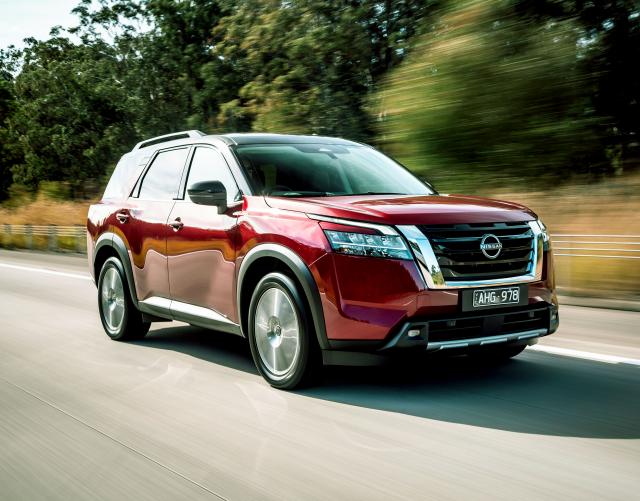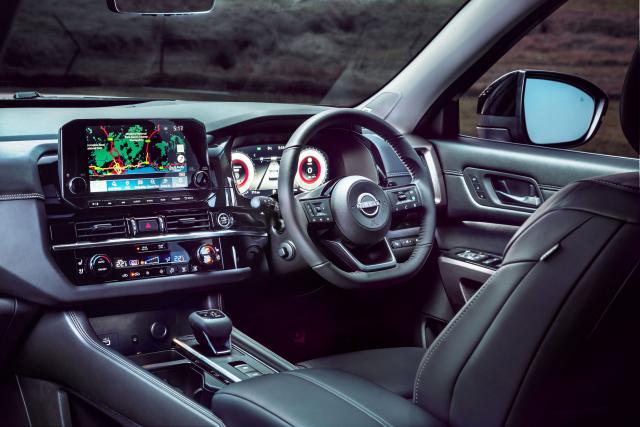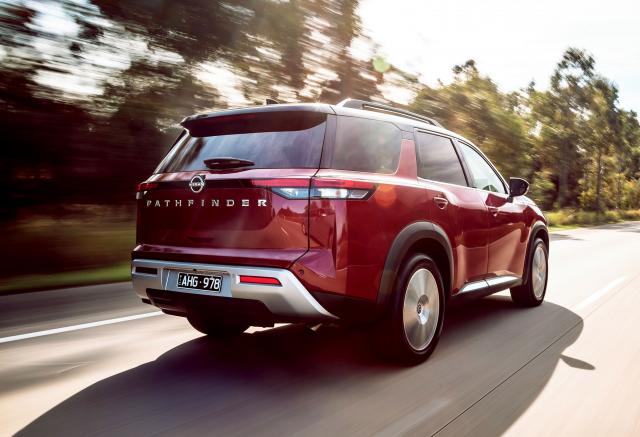How things change. Take the Nissan Pathfinder, for example, that over almost 40 years found its way from being a basic two-door compact wagon, through a big boofy 4×4, to the smart, sophisticated seven (or eight) seater sports utility vehicle of today.
Originally designed for the North American market, the initial Pathfinder was the first of the segment to be offered in two-wheel drive guise.
The fifth generation has landed Down Under with new-found modern design and a stack of high-tech features and safety systems, albeit on a platform and with a V6 engine, developments of the superseded model. The continuous variable transmission has been left behind in favour of a new nine-speed auto.
Three variants – ST, Ti and Ti-L – only are on offer in a mix of front and all-wheel drive. Diesel or hybrid options, unlike from rival carmakers such as Hyundai, Kia and Toyota, are not on the cards. Prices have gone up considerably, starting at $54,190, plus on-road costs, for the entry-level ST 2WD model, while the range topper signs off at $77,890 without ORCs.
However, where the Pathfinder finds its appeal is the offer of two seating configurations, for seven or eight. The standard three-row set-up is for eight, but stretch to the Ti-L and get into a pair of luxurious leather captain’s chairs mid cabin separated by removable centre console storage.
The test vehicle, a Ti 4WD costing $70,030, plus on-roads, came as an eight-seater with a 60:40 split second-row reclining bench. Access to the back twin seats is a doddle, even for grown-ups, with a one-touch button automatically flipping and folding the second row out of the way.
All Pathfinders are covered by a five-year unlimited kilometre warranty with round-the-clock roadside assistance for the same period.
STYLING
At more than five metres long the new Pathfinder has had its dated hard edges smoothed out, replaced by a thoroughly modern SUV-cum-coupe shape able to take up to eight people in comfort.
With black side moulding and body coloured door handles and black painted roof, highlights include chrome window surrounds and silver roof rails.
The front carries on the Nissan V-Motion theme with a large grille flanked by LED
automatic headlamps, daytime running lights and foglamps. Out back are the slimmest LED tail lamps, plus a high-mounted stop light. Each external rear vision mirror incorporates a turn signal.
Privacy glass is fitted to second row and rear windows, while 205 litres of luggage space is left with all seats in place and 54 litres under floor, leaving room only for a temporary spare wheel.
INTERIOR
Quality fit and finish are trademarks of the cabin. Black leather-accented seat and door trim is joined by a similar set-up steering wheel, the latter with tilt and telescopic adjustment.
Up front is a 10-way power driver seat and six-way manual passenger seat. The front and second row outboard positions are heated. Child restraint anchorages with second row outboard seats with ISOFIX and tether, centre seat with tether and third row left side with ISOFIX and tether.
The tri-zone climate control air-con comes with second and third row air vents.
INFOTAINMENT
A 7-inch TFT Advanced Drive-Assist Display instrument cluster is joined by a 10.8-inch head-up and 9-inch touchscreen display with satellite navigation. Wireless Apple CarPlay and wired Android Auto are backed up by a wireless smartphone charger, Bluetooth phone and audio streaming and voice recognition.
A Bose 13-speaker premium audio system includes dual subwoofer for AM / FM radio, DAB+ digital radio. USB-A and USB-C points feature throughout the cabin.
ENGINES / TRANSMISSIONS
Nothing to see here! Under the Pathfinder’s bonnet is the same 3.5-litre V6 petrol engine, delivering 202 kW and 340 Nm as before. However, the continuously variable transmission has been given the push in place of a new nine-speed auto. The Pathfinder maintains its 2.7 tonne towing capacity.
SAFETY
The Ti features front parking sensors, a surround-view monitor and Nissan’s ProPilot semi-autonomous driver assist system that connects the adaptive cruise control with stop / start and lane keeping aid.
Other features include autonomous emergency braking with junction, pedestrian and cyclist detection, rear AEB, rear cross-traffic alert, blind spot warning and intelligent blind spot intervention, rear seat alert, a driver alert, traffic sign recognition and trailer sway control.
Front seat airbags, side airbags (driver and passenger, second row outboard), front row far side airbag (centre), side curtain airbags (all rows) all helped the SUV earn a five-star safety rating recently.
DRIVING
Remote engine start has the Pathfinder firing up for a quick-ish getaway, with cabin insulation keeping the engine, wind and road noise at bay. Shift-by-wire technology is aimed at faster, smoother gearshifts.
Nissan claims a 10.5 litres per 100 kilometres on the combined urban / highway fuel cycle. The test vehicle recorded 13-plus litres per 100 kilometres in the city and suburbs and 6.4 litres per 100 kilometres on the open road.
Nissan engineers have fine-tuned the steering for a sharper response and reworked the suspension for improved levels of damping, increased roll stiffness and wider contact with the road. Overall, the Pathfinder turned in a good performance for such a big unit.
Backing up are a range of dial-up drive modes, including Sport, Eco, Snow, Sand, Mud / Rut and Tow.
SUMMARY
No longer basic, neither is it boofy as in previous iterations, the fifth-generation Pathfinder is the essence of the large SUV, with quality, comfort and safety to the fore, on and off road. Versatility is the byword, with nothing to match this, except perhaps the Hyundai Palisade.









